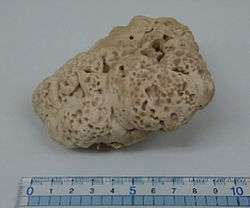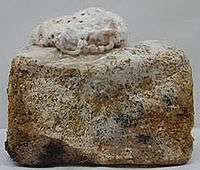Echigoshirayukidake (Basidiomycetes-X)
| Echigoshirayukidake | |
|---|---|
 | |
| Basidiomycetes-X (a hyphal mass) | |
| Scientific classification | |
| Kingdom: | Fungi |
| Division: | Basidiomycota |
| Class: | Agaricomycetes |
| Order: | Agaricales |
| Family: | Agaricaceae |
| Genus: | Agaricus |
| Species: | A. blazei x Basidiomycetes-X |
| Binomial name | |
| Agaricus blazei x Basidiomycetes-X | |
Echigoshirayukidake (Japanese: 越後白雪茸), commonly called Basidiomycetes-X or BDM-X, is a hybrid of Agaricus blazei,[1] but may be considered a new species.[2] It is classified as a basidiomycete because of its beak-shaped processes (Clamp connections). It does not form basidia and only forms sclerotia (hyphal masses) when cultured. In these respects, BDM-X is distinguished from other basidiomycetes. BDM-X, native to Niigata, Japan, is cultured and consumed as an edible mushroom.
Description
Basidiomycetes-X (BDM-X) can be cultured by an ordinary method. A cultured strain or the seed of BDM-X can be aseptically inoculated into agar, liquid, or sawdust media with suitable nutrients, and is cultured under appropriate temperature conditions.[3] The optimum growth conditions are at pH 5.0 to 6.0 and at 22 to 26℃.[3]
BDM-X forms hyphal masses in light pink colonies crowded with hyphae on the media. These sometimes grow concentrically from the site of inoculation. If a group of hyphal masses is formed within the medium, they are interconnected by mycelial strands to form a large hyphal mass .

As the shape of BDM-X depends on the environment in where it is cultured, the large hyphal masses of BDM-X for industry use can be formed, for example, on a sawdust medium (10 cm×10 cm×20 cm) after one year cultivation.

Research
Previous researches clearly show that the water extract or concentrate of BDM-X has potent anti-oxidant properties. The anti-oxidant properties of BDM-X are superior to those of Agaricus blazei, well known as an anti-tumor mushroom with antioxidant properties,[4][5] and a small molecular anti-oxidant nutrient, α-lipoic acid.[6]
- The DPPH (2,2-diphenyl-1-picrylhydrazyl) radical scavenging and ferric reduction activities of BDM-X are about two to three hold higher than that of Agaricus blazei in vitro.[7][8]
- The hydroxyl radical scavenging activity of BDM-X is approximately two to three times higher than that of Agaricus blazei in vitro.[3][8]
- The inhibitory effect of BDM-X on lipid peroxidation is more potent than that of Agaricus blazei in vitro and in ex vivo (rat liver homogenates), respectively.[7][8]
- The in vivo inhibitory effects of BDM-X on lipopolysaccharide (LPS)-induced thiobarbituric acid reactive substance (TBARS) and protein carbonyl formations as oxidative markers, are approximately two to three times higher than that of Agaricus blazei at the same dose.[8][9][10]
- The half maximal (50%) inhibitory concentration (IC50) of BDM-X and α-lipoic acid for the inhibition of LPS-induced lipid peroxidation (TBARS) in vivo, are 70 mg/ml and 700 mg/ml, respectively. And the IC50 values of BDM-X and α-lipoic acid for the inhibition of LPS-induced protein carbonyl formation in vivo, are 80 mg/ml and 500 mg/ml, respectively, in vivo.[10]
It appears that oral administration of BDM-X concentrate is suggested not only to activate the degraded immune system in aged bodies, but also to enhance NK cell and T lymphocyte activities in some terminal cancer patients, directing the immune system toward exclusion of cancer;
- The Jerne plaque technique by using retired mice, which is commonly used for screening the immune-modulating properties, indicates that oral administration of BDM-X concentrate activates degraded immune system.[3]
- In some cases of six terminal cancer patients, the administration of the BDM-X concentrate three times per day for three weeks, resulted in the increase in NK cell activity, number of NK cells and T lymphocyte activity. In one case, which showed an excellent case of response, all parameters including activity and number of NK cells, and T lymphocytes activity were increased.[3] Concerning the transient of immunological parameters after more than six months treatment in two cases of the terminal cancer, a memorable finding was that T lymphocyte activity increased remarkably in both cases. In one case, T lymphocyte activity, which had not noticeably changed during initial three weeks (from 15.5% to 13.1%), increased up to 31.6% after eight months. In another case, the T lymphocytes activity increased from 10.6% to 22.7% after eight months. This outcome using BDM-X concentrate can be equivalent to the outcome normally observed after expensive and suffering LAK (Lymphokine-activated killer cell) therapy for cancer patients.[3] Based on this finding, further studies are needed in an increased number of patients.
Administration of tablets containing BDM-X (1g/day) for two months improves atopic dermatitis symptoms;
- Concerning quality of life (QOL) and skin conditions of twenty-two outpatients with atopic dermatitis (32.1±13.0 years of age), 73% of the patients (16/22) experienced improvement in QOL relating to pruritus (itching) and in skin condition without adverse effects such as aggravation of symptoms or marked changes in blood chemistry.[11]
BDM-X is reported to suppress increased body weight and to improve impaired glucose tolerance in metabolic syndrome rats. Further studies are in progress.[12]
None of adverse events or severe side effects is reported in each trial.
Safety
The safety dose of BDM-X in human is estimated to be 150g/day (50 kg body weight). BDM-X does not induce mutagenicity in living things. Hence, it is concluded that BDM-X is an extremely safe edible mushroom.
- A subchronic oral toxicity study of BDM-X shows that no specific abnormal or adverse observation is observed even at the highest doses of 3000 mg/kg/day in body weights, food intake, homological examination, blood biochemical analysis, organ weights, or histological findings in rats.
- The mutagenicity potential of BDM-X is also assessed by the bacterial reverse mutation assay. In this study, the increase in the number of revertant colonies is never more than twice as great as that of the negative control. Furthermore, no dose-related response is observed in any strains of base-pair substitution type or frame-shift type, with or without metabolic activation.
Utilization
Since BDM-X tastes and smells good, it can be a raw, frozen, or dried edible material and also can be cooked in various ways such as simmering, pan-frying, roasting, and deep-frying, etc..
Many types of products containing extracts or powdered form of BDM-X for health and nutrition have been developed and are commercially available. While about fourteen years have passed since such BDM-X-containing products were first put on markets, no health hazard such as adverse events or severe side effect has been reported so far.
Patents
Currently, several patents of BDM-X have been established in Russia, Korea, China, Europe, Hong Kong, Japan, USA, and Australia. BDM-X is also registered as a newly discovered fungus species by the National Institute of Advanced Industrial Science and Technology (deposit no. FERMP-19241), or International Patent Organism Depositary, National Institute of Technology and Evaluation (IPOD-NITE) at present.
The Basidiomycetes-X Research Association
The Basidiomycetes-X Research Association, organized by academic researchers, started functioning in 2010 and holds an annual conference for the purposes of enrichment of academic information on BDM-X, and of returning the academic profits to human health and society.
References
- ↑ US 6120772A, Hitoshi Ito & Toshimitsu Sumiya, "Oral drugs for treating AIDS patients", issued 2000-09-19
- ↑ Watanabe, T; Nakajima, Y; Konishi, T (2008). "In vitro and in vivo anti-oxidant activity of hot water extract of basidiomycetes-X, newly identified edible fungus" (PDF). Biological & Pharmaceutical Bulletin. 31 (1): 111–7. doi:10.1248/bpb.31.111. PMID 18175952. Retrieved 3 April 2018.
- 1 2 3 4 5 6 Tetsuo Watanabe. Basidiomycetes, basidiomycetes extract composition, and health foods and immunopotentiators. PCT/JP2004/006418 Kokai November 11, 2004.
- ↑ Nakamura T., Matsugo S., Uzuka Y., Okano T., Matsuo S., Japanese Society of Mushroom Science and Biotechnology, 10, 35-41 (2002).
- ↑ Ker Y. B., Chen K. C., Chvau C. C., Chen C. C., Guo J. H., Hsieh C.L., Wang H. E., Peng C. C., Chang C. H., Peng R. Y., J. Agric. Food Chem., 53, 7052-7058 (2005).
- ↑ Atmaca G., Yonsei Medical Journal, 45, 776-788 (2004).
- 1 2 Tetsuo Watanabe. Antioxidant activities of Basidiomycetes-X extract. Proceedings of the Niigata Congress on Functional Foods for Prevention & Treatment of Life style- & Age-related Diseases (Niigata, Japan, Sept. 26-27, 2004), No. 14, p.52.
- 1 2 3 4 Yuki Nakajima, Tetsuya Konishi. In Vitro and in Vivo Anti-oxidant Activity of Hot Water Extract of Basidiomycetes-X, Newly Identified Edible Fungus. Biol Pharm Bull., 31, 111-7 (2008).
- ↑ Tetsuo Watanabe, Tetsuya Konishi. Basidiomycetes-X hot water extract can improve lipopolysaccharide (LPS)-induced oxidative stress in mice, Prospective antitumor activities of the basidiomycete. Proceedings of 27th Symposium of Japanese Society for Free Radical Research (Okayama, Japan, June 4–5, 2005), P09, p.47 (in Japanese).
- 1 2 Tetsuo Watanabe and Tetsuya Konishi. Basidiomycetes-X hot water extract can improve lipopolysaccharide (LPS)-induced oxidative stress in mice. Proceedings of 10th Japanese Society for Food Factors (JSoFF) (Okayama, Japan, November 23–25, 2006) (in Japanese).
- ↑ Kikuo Minami, Tetuo Watanabe, Susumu Yukami, Kikuo Nomoto. Clinical Trials of Basidiomycetes-X on the Patients with Atopic Dermatitis. Medicine and biology, Vol.151 No.9.
- ↑ The Proceeding of 5th conference of Basidiomycetes-X Research Association